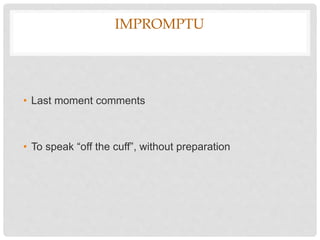Delivering the oral message
- 2. WAYS OF DELIVERING THE ORAL MESSAGE One has always four options in speaking. ŌĆó Extemporaneous ŌĆó Reading ŌĆó Memorization ŌĆó Impromptu
- 4. EXTEMPORANEOUS ŌĆó This method is preferred by audience and speakers ŌĆó These are the clearly uttered words, sort of impromptu ŌĆó Sometimes they are carefully prepared and delivered without notes. ŌĆó It allows more eye contact Verbal and non-verbal involvement with the audience
- 5. 2- READING
- 6. READING ŌĆó People made a manuscript when they donŌĆÖt want to make a mistake. ŌĆó Speakers on television often ŌĆ£readŌĆØ from a teleprompter, a device allowing them to read their words directly from script passing in front of camera lens.
- 8. MEMORIZATION ŌĆó Few speakers memorize whole speech ŌĆó There is a risk of forgetting the precise words ŌĆó Groping for words in front of an audience decreases your credibility
- 9. 4- IMPROMPTU
- 10. IMPROMPTU ŌĆó Last moment comments ŌĆó To speak ŌĆ£off the cuffŌĆØ, without preparation
- 11. STRATEGIES FOR AN EFFECTIVE ORAL DELIVERY ŌĆó Pitch Monotone High or low voice Same word value ŌĆó Rate ŌĆó Volume Contrast in emphasis Controlled Breathing
- 12. CONTINUEDŌĆ”. ŌĆó Vocal quality Relaxing the throat, allowing an unrestricted sound to enter the chambers of mouth, throat and nasal cavities. ŌĆó Pronunciation Varied Regional Accents Added or omitted sounds Listen to educated and cultural people Consult a recent dictionary
- 13. STRATEGIES FOR EFFECTIVE NON- VERBAL DELIVERY ŌĆó Posture: how you stand ŌĆó Movement Move to hold attention Move to get rid of nervousness Move to suggest transitions Move to increase emphasis
- 14. CONTINUED ŌĆó Gesture Illustrators Affect displays Regulators Adaptors To emphasize To point Vary gestures Watch timings
- 15. CONTINUED ŌĆó Facial Expression ŌĆó Appearance
















